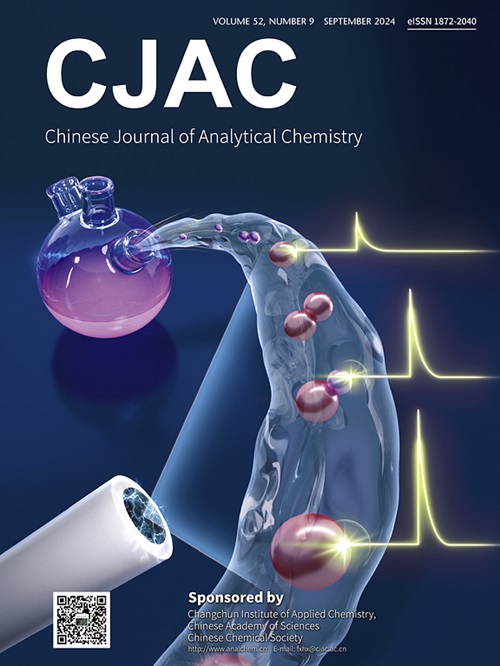菲律宾竹外多糖的提取、结构表征及生物活性研究
IF 1.3
4区 化学
Q4 CHEMISTRY, ANALYTICAL
引用次数: 0
摘要
研究了蛤肉外多糖的提取、结构表征及生物活性。其目的是开发具有潜在药用或保健价值的低成本和新型动物多糖。超声辅助法提取粗多糖得率为10 g/100 g。通过DEAE-52柱层析和HW-65F柱层析,得到了两个分离的胞外多糖(RPP-1A和RPP-2A)。RPP-1A的主要单糖成分为Glc、GalA、GlcA、Rha和Rib,而RPP-2A的主要单糖成分为GlcA、Rha和Rib。利用傅里叶变换红外(FT-IR)和核磁共振(NMR)进一步研究了RPP-1A和RPP-2A,结果表明RPP-1A由一个主残基链组成,表示为:[→6-α- glc -(1→4)-β- gala -(1→6)-α- glc -(1→4)-β- gala -(1→)]。侧链重复单元结构为[β-GlcA-(1→4)-α-Glc-(1→3)-α- rib -(1→4)-α- rha -(1→)],连接在Glc的C-2位主链上。RPP-2A代表RPP-1A的侧链部分[β-GlcA-(1→4)-α- glc -(1→3)-α- rib -(1→4)-α- rha -(1→)]。扫描电镜(SEM)分析显示了不同组分的特征形貌。x射线衍射表明多糖由结晶区和无定形区组成。抗氧化活性测定表明,RPP-1A和RPP-2A对DPPH自由基、ABTS自由基阳离子、羟基自由基均有较强的抗氧化作用,其中RPP-2较强。此外,它们还能显著抑制Hela、HepG2癌细胞的增殖,且HepG2对RPP-2A更为敏感。综上所述,RPPs作为一种天然抗氧化剂在功能性食品中具有很大的潜力,是治疗癌症的有希望的候选者。本文章由计算机程序翻译,如有差异,请以英文原文为准。

Extraction, structural characterization and biological activities of exopolysaccharides from Ruditapes philippinarum
This study investigated the extraction, structural characterization and biological activities of exopolysaccharides from clam meat. The aim of this is to develop low-cost and novel animal polysaccharides with potential medicinal or health benefits. A crude polysaccharide yield of 10 g/100 g was extracted by the ultrasonic-assisted method. Two fraction exopolysaccharides (RPP-1A and RPP-2A) were obtained through DEAE-52 column chromatography and HW-65F column. Glc, GalA, GlcA, Rha and Rib were the main monosaccharides components of RPP-1A, whereas RPP-2A was primarily composed of GlcA, Rha and Rib. RPP-1A and RPP-2A were further investigated using Fourier transformed infrared (FT-IR) and nuclear magnetic resonance (NMR) that the results showed that RPP-1A comprised a main chain of residues represented as: [→6-α-Glc-(1 → 4)-β-GalA-(1 → 6)-α-Glc-(1 → 4)-β-GalA-(1→]. The side chain repeating unit structure is [β-GlcA-(1 → 4)-α-Glc-(1 → 3)-α-Rib-(1 → 4)-α-Rha-(1→], attached to the main chain at the C-2 position of Glc. RPP-2A represents the side chain portion of RPP-1A [β-GlcA-(1 → 4)-α-Glc-(1 → 3)-α-Rib-(1 → 4)-α-Rha-(1→]. Scanning electron microscopy (SEM) analysis revealed that the characteristic morphology of different fractions. X-ray diffraction showed that the polysaccharides consisted of crystalline and amorphous regions. Furthermore, assays of antioxidant activity showed that any one of RPP-1A and RPP-2A had antioxidant effects against DPPH radical, ABTS radical cation, hydroxyl radical, among which RPP-2 was stronger. In addition, they significantly inhibited the proliferation of Hela, and HepG2 cancer cells, and HepG2 was more sensitive to RPP-2A. In general, the results demonstrated that RPPs had great potential as a natural antioxidant in the functional food, and they are promising candidates for cancer treatment.
求助全文
通过发布文献求助,成功后即可免费获取论文全文。
去求助
来源期刊
CiteScore
3.60
自引率
25.00%
发文量
17223
审稿时长
35 days
期刊介绍:
Chinese Journal of Analytical Chemistry(CJAC) is an academic journal of analytical chemistry established in 1972 and sponsored by the Chinese Chemical Society and Changchun Institute of Applied Chemistry, Chinese Academy of Sciences. Its objectives are to report the original scientific research achievements and review the recent development of analytical chemistry in all areas. The journal sets up 5 columns including Research Papers, Research Notes, Experimental Technique and Instrument, Review and Progress and Summary Accounts. The journal published monthly in Chinese language. A detailed abstract, keywords and the titles of figures and tables are provided in English, except column of Summary Accounts. Prof. Wang Erkang, an outstanding analytical chemist, academician of Chinese Academy of Sciences & Third World Academy of Sciences, holds the post of the Editor-in-chief.

 求助内容:
求助内容: 应助结果提醒方式:
应助结果提醒方式:


